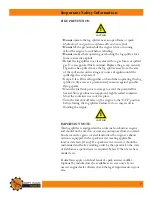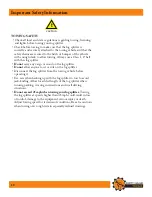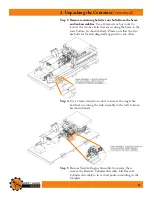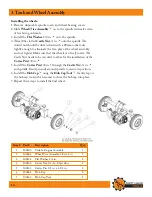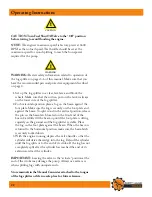
21
Operating Instructions
Step 2:
After the hydraulic reservoir and the engine crankcase
are filled with oil, start the engine. The hydraulic pump is
TFMGQSJNJOH8JUIUIFFOHJOFSVOOJOHNPWFUIFIZESBVMJD
valve lever toward the foot plate. This will cause the cylinder
to extend and expel air. When the cylinder is fully extended,
retract it. Repeat this procedure several times. An erratic
movement of the cylinder indicates that there is still air in the
system. Add about 1.0 to 1.5 gallons of hydraulic fluid. Five
gallons will register just above the top fill line on the dip stick.
The total capacity of the entire hydraulic system is 6.5 gallons,
5 gallons of hydraulic fluid is the minimum required to operate.
95 5."5.(%5#-5)0,ŀ&&5#.51#&&52*&5)#&5 ,)'5."5
breather cap when the cylinder is retracted. Cycle the
cylinder again until it has a constant speed which indicates
that all air has been expelled.
STARTING INSTRUCTIONS
NOTE:
Refer to the Engine Owner’s Manual for complete
information on starting, maintenance and troubleshooting.
1. Move the fuel valve lever to the ON position.
5PTUBSUBDPMEFOHJOFNPWFUIFDIPLFMFWFSUPUIF$-04&
position. To restart a warm engine, leave the choke lever in
the OPEN position.
.PWFUIFUISPUUMFMFWFSBXBZGSPNUIF4-08QPTJUJPO
BCPVUPGUIFXBZUPXBSEUIF'"45QPTJUJPO
4. Turn the engine switch to the ON position.
5. Pull the starter grip until you feel resistance, then pull
briskly. Return the starter grip gently.
*GUIFDIPLFMFWFSIBTCFFONPWFEUPUIF$-04&QPTJUJPO
to start the engine, gradually move it to the OPEN position
as the engine warms up.
7. To stop the engine in an emergency, simply turn the engine
switch to the OFF position. Under normal conditions,
NPWFUIFUISPUUMFMFWFSUPUIF4-08QPTJUJPOBOEUIFO
turn the engine switch to the OFF position. Then turn the
fuel valve lever to the OFF position.
For further information on starting and stopping the engine,
refer to your engine owner’s manual.



